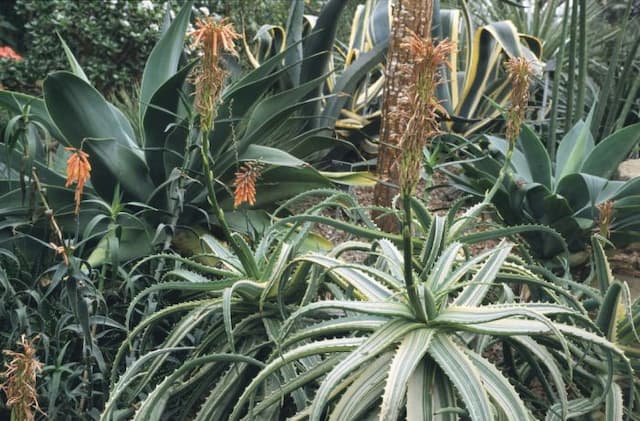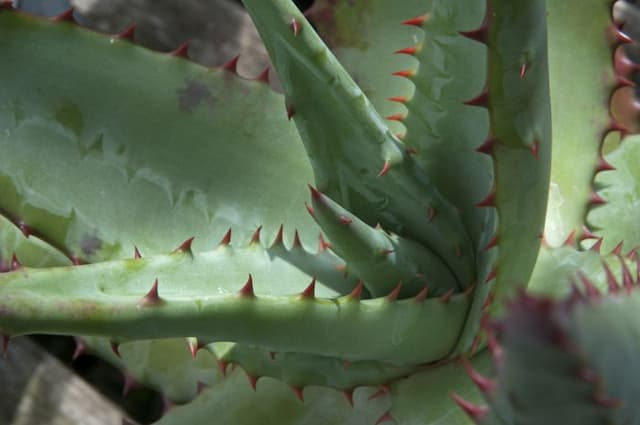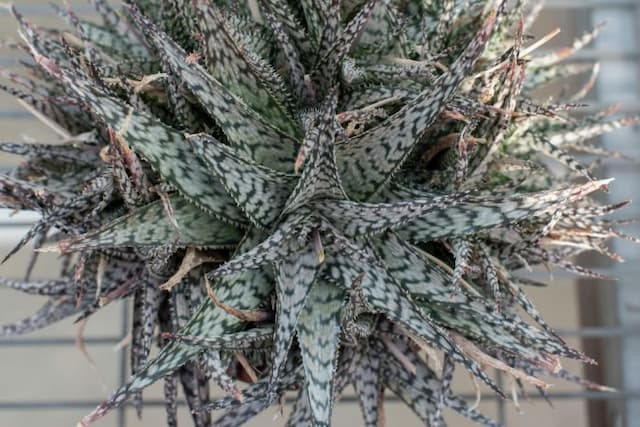Illyrian Lily Asphodeline liburnica

ABOUT
Asphodeline liburnica, commonly known among gardeners as Jacob's Rod, is an eye-catching perennial plant. Its overall form is upright and spiky, creating a strong vertical element in the landscape. The foliage of Jacob's Rod consists of a clump of narrow, dark green, grass-like leaves, which are somewhat fleshy and often have a blue-green hue. These leaves give the plant a tufted look at the base. As spring turns to summer, Jacob's Rod produces tall, spike-like flower stalks. The blossoms arrayed along these stalks are star-shaped, typically bright yellow, sometimes with a greenish tinge, and have a slightly waxy appearance. They bloom progressively from the bottom up, creating a lengthy display of color. When the plant is not in flower, its striking foliage serves as an elegant and textural backdrop in the garden. After flowering, Jacob's Rod develops brown, three-sided seed capsules, which also have ornamental value. In addition to these striking visual features, the plant can also be recognized by its dry habitat preference and its affinity for sunny locations. Overall, Jacob's Rod adds a burst of bright color and an exotic look wherever it is planted.
About this plant
 Names
NamesFamily
Asphodelaceae
Synonyms
Illyrian Asphodel
Common names
Asphodeline liburnica Scop., Asphodelus luteus L., Asphodelus ramosus subsp. liburnicus (Scop.) Hayek, Proteleia liburnica (Scop.) Á.Löve & D.Löve.
 Toxicity
ToxicityTo humans
Asphodeline liburnica, commonly known as the Yellow Asphodel, is not widely recognized for its toxicity to humans. There is limited information available regarding its toxic principles or the consequences of ingestion. If any parts of the plant were poisonous, symptoms might typically include gastrointestinal upset, such as nausea, vomiting, or diarrhea. However, specific symptoms of poisoning from Yellow Asphodel are not well-documented. It is always advisable to avoid ingesting parts of plants that are not known to be safe and to seek medical attention if symptoms occur.
To pets
Yellow Asphodel (Asphodeline liburnica) is not commonly reported as toxic to pets. However, the lack of detailed information on its toxicity means that caution should be exercised. Pets should not be encouraged to eat any part of this plant. If a pet does ingest Yellow Asphodel, watch for signs of gastrointestinal distress or other symptoms of poisoning, and contact a veterinarian if any concerns arise.
 Characteristics
CharacteristicsLife cycle
Perennials
Foliage type
Deciduous
Color of leaves
Green
Flower color
Yellow
Height
2 feet (0.61 meters)
Spread
1 foot (0.3 meters)
Plant type
Herb
Hardiness zones
7
Native area
Mediterranean
Benefits
 General Benefits
General Benefits- Landscape Aesthetics: Asphodeline liburnica, commonly known as Jacob's rod, adds visual interest to gardens and landscapes with its striking yellow flowers and vertical growth form.
- Attracts Pollinators: The vibrant blossoms of Jacob's rod are attractive to bees and other pollinators, helping to support local biodiversity.
- Drought Tolerance: Jacob's rod is well-suited to xeriscaping, as it is capable of withstanding periods of drought once established, making it ideal for water-conserving gardens.
- Low Maintenance: It requires minimal care once established, making it a convenient choice for gardeners with limited time.
- Edible Uses: Some parts of the plant are known to be edible, such as the buds, which have been historically consumed in the plant's native range.
- Cultural Significance: Asphodeline liburnica has historical significance in its native region, and can be used to create a garden with a Mediterranean or ethnobotanical theme.
- Soil Stabilization: The root system can help to stabilize soil and prevent erosion on slopes or in areas prone to soil degradation.
- Seasonal Interest: Jacob's rod provides seasonal interest through its long blooming period, typically from late spring to early summer.
 Medical Properties
Medical PropertiesThis plant is not used for medical purposes.
 Air-purifying Qualities
Air-purifying QualitiesThis plant is not specifically known for air purifying qualities.
 Other Uses
Other Uses- Asphodeline liburnica, commonly known as Jacob's Rod, can be used as a natural dye source, producing a range of yellow tones depending on the mordant used.
- The fibers from the leaves of Jacob's Rod can be processed and used in traditional textile crafts for the production of ropes or coarse fabrics.
- Jacob's Rod can be incorporated into ornamental garden designs for its striking yellow flowers and structural height, adding vertical interest.
- The rods of the plant have been historically used as measuring sticks by rural populations due to their consistent and straight growth habit.
- Jacob's Rod can be used in dried flower arrangements, adding a rustic and long-lasting element to the composition.
- The flowering spikes of Jacob's Rod may serve as an ecological indicator for certain soil types, such as calcareous soils, assisting in biological field surveying.
- Plant enthusiasts have used the seeds of Jacob's Rod to exchange with other gardeners, promoting biodiversity and the sharing of unique plant species.
- Jacob's Rod has been part of cultural symbolism and folklore, often associated with tranquility and peace, which can be infused into artistic representations and literary allusions.
- The plant's unusual structure makes it an interesting subject for botanical studies, especially for educational purposes in schools or nature programs.
- Jacob's Rod provides habitat and food for a variety of pollinators, including bees and butterflies, thus playing a role in supporting local ecosystems.
Interesting Facts
 Feng Shui
Feng ShuiThe Asphodel lily is not used in Feng Shui practice.
 Zodiac Sign Compitability
Zodiac Sign CompitabilityThe Asphodel lily is not used in astrology practice.
 Plant Symbolism
Plant Symbolism- Immortality: Asphodeline, often associated with the asphodel meadows, is believed in Greek mythology to be a favorite of the dead, symbolizing an everlasting existence.
- Mourning: The somber beauty of the plant reflects sorrow and is sometimes used to express sympathy and remembrance for the deceased.
- Regeneration: As a perennial plant, the ability of Asphodeline liburnica to return each year can symbolize renewal and the cycle of life and death.
 Water
WaterJacob's Rod, also known as Asphodeline liburnica, prefers moderate watering. It should be watered deeply when the top inch of the soil feels dry. This may translate to watering approximately once a week, but always check soil moisture before watering. The amount of water required may vary, but generally, it will need around 1 gallon per week during active growth periods. It is important to avoid overwatering to prevent root rot, particularly during the dormant winter months when it may require less frequent watering.
 Light
LightJacob's Rod thrives in full sun conditions where it can receive at least 6 to 8 hours of direct sunlight a day. The best spot for this plant is in a location where it's exposed to unfiltered sunlight for most of the day. Avoid placing it in deep shade or an overly dark area, as insufficient light can impede its growth and flowering.
 Temperature
TemperatureJacob's Rod does well in a wide range of temperatures but prefers to be kept in an environment that stays within 50°F to 80°F for optimal growth. It is cold hardy and can tolerate temperatures down to around 0°F, making it suitable for gardens in various climates. Avoid exposing the plant to prolonged periods of temperatures above 80°F, as high heat may stress the plant, especially if humidity is also high.
 Pruning
PruningJacob's Rod should be pruned to remove spent flower stalks after blooming and to tidy up any dead or damaged foliage. This is typically done in late fall or early winter. Pruning encourages new growth and maintains an attractive shape. Minimal pruning is required; just focus on the removal of old growth and trimming back as needed to keep the plant healthy and prevent it from becoming too leggy.
 Cleaning
CleaningAs needed
 Soil
SoilThe Jacob's Rod prefers well-draining soil mixed with sand and peat for optimum growth. The best soil mix would be equal parts of loamy soil, coarse sand, and peat to ensure good drainage and aeration. The soil pH ideal for Asphodeline liburnica is slightly alkaline, around 7.5 to 8.0.
 Repotting
RepottingJacob's Rod typically requires repotting every two to three years. Asphodeline liburnica should be repotted when it outgrows its current container, which is generally noticeable when the roots start to circle the pot's bottom or protrude through the drainage holes.
 Humidity & Misting
Humidity & MistingJacob's Rod thrives best in moderate humidity conditions. The plant is accustomed to the dry Mediterranean climate, so it is tolerant of less humid conditions, but does not require high humidity levels found in more tropical environments.
 Suitable locations
Suitable locationsIndoor
Place in bright, indirect light and keep soil moderately dry.
Outdoor
Plant in full sun, in well-draining, lean soil.
Hardiness zone
5-9 USDA
 Life cycle
Life cycleAsphodeline liburnica, commonly known as Jacob's Rod, begins its life cycle when seeds germinate, usually requiring well-drained soil and plenty of sunlight. The young seedlings develop a root system and foliage, forming a rosette of narrow, lance-shaped leaves. As the plant matures, it develops a flowering stalk, which can reach up to 60 cm tall, bearing yellow star-shaped flowers that bloom from late spring to early summer. After pollination, typically by bees, the flowers develop into three-chambered capsules containing black seeds. Once the seeds are dispersed by wind or animals, the plant enters a period of dormancy during the colder months. Annual growth occurs in the spring when environmental conditions become favorable again, continuing the cycle.
 Propogation
PropogationPropogation time
Spring-Early Summer
Asphodeline liburnica, commonly known as Jacob's Rod, is typically propagated through division, which is a popular method for this perennial plant. The best time to divide and propagate Jacob's Rod is in the spring or early fall, when the plant is not in active bloom. The process involves carefully digging up an established clump of the plant and gently teasing apart the root mass into several sections, each with an adequate amount of roots and shoots. These sections are then planted in well-draining soil, preferably enriched with organic matter, at the same depth they were growing previously. It is important to water the new divisions thoroughly after planting to help establish them. Proper spacing should be considered to allow for mature growth, generally around 18 inches to 24 inches (approximately 45 to 60 centimeters) apart.









